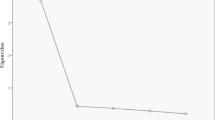Summary
The risk factors of high trait anger of juvenile offenders were explored through questionnaire study in a youth correctional facility of Hubei province, China. A total of 1090 juvenile offenders in Hubei province were investigated by self-compiled social-demographic questionnaire, Childhood Trauma Questionnaire (CTQ), and State-Trait Anger Expression Inventory-II (STAXI-II). The risk factors were analyzed by chi-square tests, correlation analysis, and binary logistic regression analysis with SPSS 19.0. A total of 1082 copies of valid questionnaires were collected. High trait anger group (n=316) was defined as those who scored in the upper 27th percentile of STAXI-II trait anger scale (TAS), and the rest were defined as low trait anger group (n=766). The risk factors associated with high level of trait anger included: childhood emotional abuse, childhood sexual abuse, step family, frequent drug abuse, and frequent internet using (P<0.05 or P<0.01). Birth sequence, number of sibling, ranking in the family, identity of the main care-taker, the education level of care-taker, educational style of care-taker, family income, relationship between parents, social atmosphere of local area, frequent drinking, and frequent smoking did not predict to high level of trait anger (P>0.05). It was suggested that traumatic experience in childhood and unhealthy life style may significantly increase the level of trait anger in adulthood. The risk factors of high trait anger and their effects should be taken into consideration seriously.
Similar content being viewed by others
References
Spielberger CD, Reheiser EC, Sydeman SJ. Measuring the experience, expression, and control of anger. Issues Compr Pediatr Nurs, 1995,18(3): 207–232
Spielberger CD. Professional manual for the State-Trait Anger Expression Iventory-2 (STAXI-2). Odessa, FL: Psychological Assessment Resources, 1999.
Luo YL, Zhang DJ, Liu YB, et al. Reliability of the Chinese version of Trait Anger scale in college students. Chin Mental Health J (Chinese), 2011,25(9): 700–704
Luo YL, Zhang DJ. An experimental study of attentional bias to negative emotion facial expressions in high trait anger individuals. J Psychol Sci (Chinese), 2011,34(2): 322–327
Bernstein DP, Fink L. Childhood Trauma Questionnaire: A Retrospective Self-Report: Manual. San Diego, CA: Harcourt Brace & Company, 1998.
Walker EA, Unutzer J, Rutter C, et al. Costs of health care use by women HMO members with a history of childhood abuse and neglect. Arch Gen Psychiat, 1999,56(7): 609–613
Zhang M. Reliability and validity of the Chinese version of CTQ-SF. Chin J Public Health (Chinese), 2011,27(5): 669–670
Sudbrack R, Manfro PH, Kuhn IM, et al. What doesn’t kill you makes you stronger and weaker: How childhood trauma relates to temperament traits. J Psychiatr Res, 2015,62: 123–129
Plattner B, Karnik N, Jo B, et al. State and trait in delinquent adolescents. Child Psychiatry Hum Dev, 2007,38: 155–169
Yang LH, Ma XL, Zhang H. The effect of childhood neglect on self-injury behavior in junior high school students–the mediating effect of social support. Jiao Yu Li Lun Yu Shi Jian (Chinese), 2015,35(2): 17–19
Wu WW, Lu SJ, Wei LG, et al. Relationship between childhood maltreatment experience, cognitive bias and depression. Chin J Clin Psychol (Chinese), 2013,21(4): 609–612
Eftekhari A, Turner AP, Larimer ME. Anger expression, coping, and substance use in adolescent offenders. Addict Behav, 2004,29(5): 1001–1008
Nichols TR, Mahadeo M, Bryant K, et al. Examining anger as a predictor of drug use among multiethnic middle school students. J School Health, 2008,78(9): 480–486
Li WM, Guo YL, Li J, et al. Correlation analysis between negative emotions and substance abuse among urban adolescents. Chin J Sch Health (Chinese), 2010,31(6): 685–686
Sharma MK, SumanLN, Murthy P, et al. State-trait anger and quality of life among alcohol users. German J Psychiatry, 2011,14(2): 60–65
Parrott DJ, Giancola PR. A further examination of the relation between trait anger and alcohol-related aggression: the role of anger control. Alcohol Clin Exp Res, 2004,28(6): 855–864
Cougle JR, Zvolensky MJ, Hawkins KA. Delineating a relationship between problematic anger and cigarette smoking: A population-based study. Nicotine Tob Res, 2013,15(1): 297–301
Li Y, Wang LG, Zhou WJ, et al. Online aggression behaviors and anger in middle school students. Chin Mental Health J (Chinese), 2012,26(7): 532–536
Cao YP, Zhang YL, Yang SC, et al. A comparative study on the patterns of domestic violence. Chin J Clin Psychol (Chinese), 2008,16(1): 28–30
Acknowledgements
We would like to thank the staff at the Youth Correctional Facilities of Hubei Province for their support and cooperation.
Author information
Authors and Affiliations
Corresponding author
Additional information
This project was supported by National Natural Science Foundation of China (No. 81373022).
Rights and permissions
About this article
Cite this article
Tang, Ln., Ye, Xz., Yan, Qg. et al. Factors associated with trait anger level of juvenile offenders in Hubei province: A binary logistic regression analysis. J. Huazhong Univ. Sci. Technol. [Med. Sci.] 37, 20–24 (2017). https://doi.org/10.1007/s11596-017-1688-x
Received:
Revised:
Published:
Issue Date:
DOI: https://doi.org/10.1007/s11596-017-1688-x




